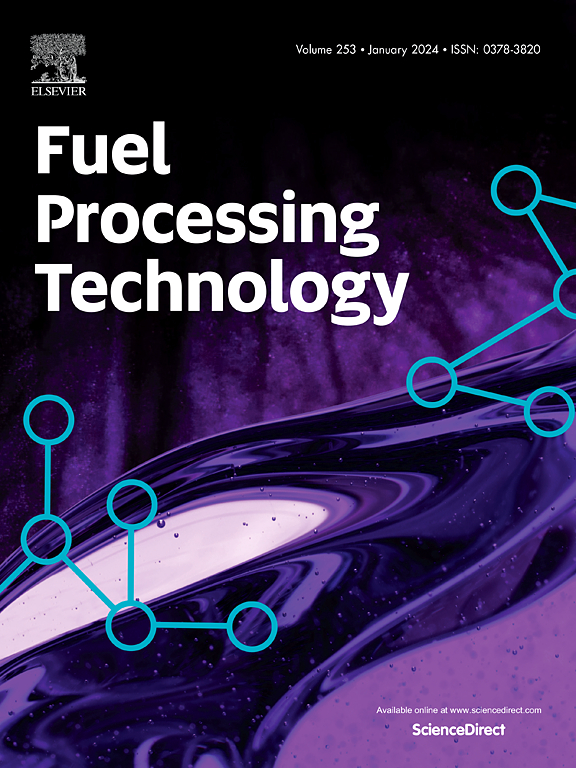Experimental and numerical studies on the NO reaction pathways of NH3 cofiring with coal volatile matter
IF 7.2
2区 工程技术
Q1 CHEMISTRY, APPLIED
引用次数: 0
Abstract
Ammonia (NH3) cofiring provides a promising solution to carbon reduction of coal-fired boilers, but it may lead to increased NOx emissions. However, many experiments observed that the NOx emissions exhibited an increase-then-decrease trend with the increase of NH3 cofiring ratio (RNH3), indicating that NOx could be controlled under high RNH3. To reveal the underlying mechanism, the experiments of NH3 cofiring with coal volatile were first conducted in a one-dimensional flow reactor to reveal that this trend is primarily attributed to the gaseous reactions of volatile and NH3. A chemical reactor network model was then constructed to investigate the influences of RNH3 on the NO reaction pathways of NH3. The predicted results replicated the increase and then decrease trend of NOx emissions as RNH3 increased beyond 25 %. It was found that NO formation is primarily controlled by the reactions between HNO/N and OH/H radicals. Under lower RNH3, the concentrations of HNO/N increase with the increase of RNH3 leading to increased NO formation. Under higher RNH3, however, much of the OH/H radicals are consumed by the dehydrogenation reactions of NH3 which consequently inhibits the NO formation reactions. Therefore, the root mechanism of the increase-then-decrease trend of NOx emissions is attributed to the competition for the OH/H radicals between the initial and final steps of the NO formation reaction pathway.
NH3与煤挥发物共烧NO反应途径的实验与数值研究
氨(NH3)共烧为燃煤锅炉的减碳提供了一种很有前景的解决方案,但它可能导致NOx排放增加。然而,许多实验观察到,随着NH3共烧比(RNH3)的增加,NOx排放量呈现先增加后减少的趋势,表明在高RNH3条件下,NOx可以得到控制。为了揭示其潜在的机理,首先在一维流动反应器中进行了NH3与煤挥发物共燃的实验,揭示了这种趋势主要归因于挥发物与NH3的气态反应。建立了化学反应器网络模型,研究了RNH3对NH3 NO反应途径的影响。预测结果与RNH3浓度大于25%时氮氧化物排放量先增加后减少的趋势一致。结果表明,NO的形成主要受HNO/N和OH/H自由基的反应控制。在低RNH3条件下,随着RNH3浓度的增加,HNO/N浓度增加,导致NO生成增加。然而,在较高的RNH3下,大部分OH/H自由基被NH3的脱氢反应消耗,从而抑制NO的生成反应。因此,NOx排放量先增加后减少的根本机制是NO形成反应途径的初始和最终步骤之间对OH/H自由基的竞争。
本文章由计算机程序翻译,如有差异,请以英文原文为准。
求助全文
约1分钟内获得全文
求助全文
来源期刊

Fuel Processing Technology
工程技术-工程:化工
CiteScore
13.20
自引率
9.30%
发文量
398
审稿时长
26 days
期刊介绍:
Fuel Processing Technology (FPT) deals with the scientific and technological aspects of converting fossil and renewable resources to clean fuels, value-added chemicals, fuel-related advanced carbon materials and by-products. In addition to the traditional non-nuclear fossil fuels, biomass and wastes, papers on the integration of renewables such as solar and wind energy and energy storage into the fuel processing processes, as well as papers on the production and conversion of non-carbon-containing fuels such as hydrogen and ammonia, are also welcome. While chemical conversion is emphasized, papers on advanced physical conversion processes are also considered for publication in FPT. Papers on the fundamental aspects of fuel structure and properties will also be considered.
 求助内容:
求助内容: 应助结果提醒方式:
应助结果提醒方式:


